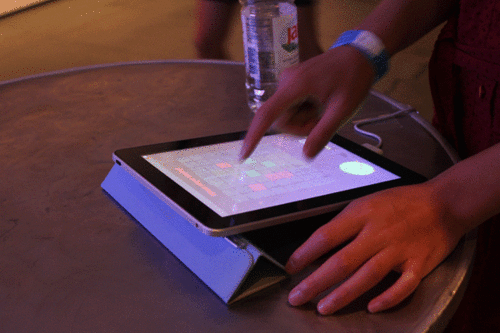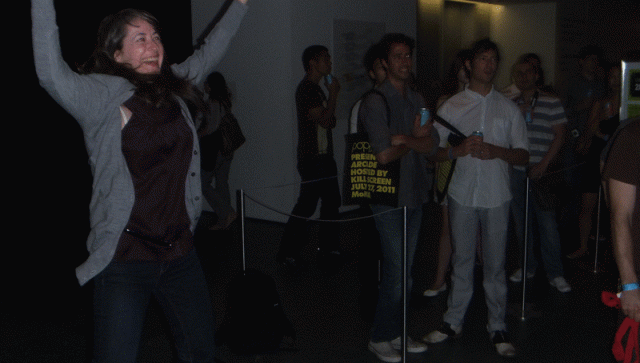What happens when you meld the most futuristic Microsoft technology with the most futuristic Apple technology with the most ColecoVision-esque graphics as built in Jitter? Or you create gameplay that couples physical human contortion with the step sequencing rhythms of music? A different take on music games, that’s what.
Developers Matt (“M@tt”) Boch and Ryan Challinor work, in their day jobs, on the music game as most people know it, at Harmonix. Harmonix’s roots remain in the rhythm game, so that music play, even at its most serious, is still about musical timing accuracy. Pxl Pusher is a very different mechanic: imagine a step sequencer grid on an iPad, presenting blocks that, true to the classic game Twister, require another player to balance and stretch their bodies to match.
I caught up with Matt and Ryan over the summer at New York’s Museum of Modern Art. Before throngs of crowds swarmed the game – easily one of the most popular of the night – I managed to get some quick footage of the creators doing last-minute patching and trying out gameplay. (The quiet there is atypical; we got to shoot before the doors opened.) An insane travel schedule kept me from publishing sooner, but here, Matt and Ryan share their process.
Another interesting twist: Max/MSP and Jitter allowed extremely rapid prototyping with Kinect, something of interest to anyone doing this sort of work. (And dig those “3D” images … if they don’t blind you.)
CDM: How did you work together on this project?
Matt: Jamin from Kill Screen had asked me to make a project for the Pop Rally, and I was looking for someone to team up with to make it happen. Around the same time, Ryan was developing Synapse, and I got super excited about that tech. Having worked with him closely on Dance Central 2, I was positive we’d make a killer team, so I proposed we team up and make it happen. He got the ball rolling immediately.
Max/MSP is a pretty ideal environment for the both of us to work in, as it lets us evaluate ideas really quickly, and completely obliterate the lines between disciplines that we’re used to in traditional game development. Each of us designed, coded, sound designed, and made art for the game. It was awesome to be able to share in the creation of all parts of the game.
Ryan: We riffed on ideas with each other until it snowballed into the final product. Max allowed us both to work in the same space, as opposed to the traditional programmer/designer arrangement, where I would work in code and Matt would tweak values that I expose. This allowed us to work much faster and blurred the line between programmer and designer.
Any roadblocks, discoveries along the way?
Ryan: The whole project was driven by discovery: discover a fun interaction, then figure out how to leverage it. There were no real roadblocks, other than Matt being on painkillers for the entirety of the project!
Matt: I fell, knocked out four teeth, and fractured my jaw, so I was on heavy doses of painkillers for much of the development. I’m doing much better now, almost fully recovered.
The greatest discovery for me was more of a rediscovery. I remembered how freeing it is to design a game for a very specific context. Before working at Harmonix, I made arcade games in a contemporary art context. Getting back into that mindset was a blast.
Tell us a bit how you work with Max for rapid prototyping. How did you set it up? Any specific tools you made use of? Any tips, either related to Max or Kinect specifically?
Ryan: No real tips for Max, other than do a lot of commenting when you’re working on a file with someone else. As far as Kinect tips, my main advice would be to explore and discover what fun you can have with he input, other than starting with a specific goal. The only tools we used outside of Max were Synapse for the Kinect data, Adobe Premiere for the background movie, and some web app Matt used to generate some of the sound effects.
Matt: We ended up using Beanstalkapp & Versions for version control, which was huge for us in the late stages of development when we both needed to be working simultaneously. It was great that we structured our patch in such a way that we could easily turn elements of the patch into standalone patches, so simultaneous work could happen. You lose some flexibility, but it’s worth it to be able to work in tandem.
How did you conceive the idea for this game?
Matt: Largely through iteration and idea exchange. I VJ around Boston a fair amount and often used TouchOSC to VJ with my iPhone, so I’m not stuck behind my laptop for hours at a time, so when Ryan brought up the idea of using TouchOSC with MAX and Synapse, I was totally sold. We quickly arrived at the mashup between Twister and Step Sequencer, and every after that was polishing mechanics, arriving at a unified aesthetic, and then finding the best way to ramp difficulty.
Ryan: Matt approached me to work on a game for the PopRally right around when I just finished up Synapse, so I wanted to leverage that in the project. I had also just learned about TouchOSC, so I thought it could be fun to incorporate that. So, the initial concept was born out of experimenting with interactions that combined the Kinect and iPad.
How did things go at MOMA? Any surprises in terms of reception? It was effectively rapid playtesting — anything that you would now incorporate into the game? Or things that worked well, for that matter?
Matt: It was a phenomenal success. I never imagined we’d have a line of people waiting to play the game all night, never mind a line full of people cheering, laughing, and clapping as they watched others play. We’ve talked a bit about ways to modify the existing game to make it a bit deeper and more broadly compatible, but I’m also wary of upsetting the balance we arrived at.
Ryan: I was pleased with the reception at MoMA, it was very satisfying to work on a project and then immediately have people playing it, literally 10 minutes after it was finished (thanks to a last-minute feature request from Matt’s friend Christina)
What does it mean to you to have this game in this landmark art museum?
Ryan: I’m really grateful that we were able to show it off in such an amazing space. It feels a little unreal to me, my brain hasn’t really processed it yet.
Matt: It was hugely validating, especially because my Dad was in town and was able to make it to the event. He’s never seen crowds of people play the games I’ve worked on so to have him there, seeing how much fun everyone was having, was awesome in and of itself. That it was at the MoMA? Still haven’t totally processed it. It was the stuff of dreams when I was getting my art degree; it’s going to take a bit for me to internalize that that dream was realized. Not only was I able to show work at the MoMA, but it was shown in the context of so many great games: Bit.Trip Beat, Limbo, B.U.T.T.O.N., QWOP, the list goes on…
How about the connection to Kill Screen Magazine?
Matt: I think Kill Screen is far and away the best game writing happening right now. Both their daily updates on the web and their themed print issues are staples in my life. To be fair, I might be biased as I’m good friends with [editor-in-chief] Jamin, but nevertheless, I think what they’ve accomplished is undeniably phenomenal. What other publication could convince the MoMA to have a video game night?
Can you tell us a bit about your roles at Harmonix, and how you came to be there?
Ryan: I’m a programmer at Harmonix, I’ve worked on The Beatles: Rock Band and the Dance Central series. I was a CS major at the University of Texas, I got an internship at a game studio in Austin that turned into a job, then a few years later a coworker talked me up to someone he met from Harmonix, and I got recruited to work there.
Matt: I am a Project Lead at Harmonix, though I’ve occupied many roles previously, most recently Senior Designer. I started at Harmonix as a Production Assistant while I was finishing my thesis at Harvard. My friend and VJ partner, Josh Randall, is the Creative Director of Harmonix. We’d been VJing together for a bit while I was in school. He gave me a call one day, suggesting I apply for a Production Assistant role. One of my jobs was to track all the prototype hardware, but I ended up spending most of my time repairing it, as my art practice of building arcades gave me a fair amount of experience about mechanical engineering, electronic engineering, and coding. That landed me a role as hardware designer, and, many Rock Band iterations and trips to China later, I was tasked with investigating tech for a potential dance game. That lead to me heading up the development of a game prototype that would become Dance Central, and I’ve been designing for the franchise ever since. A circuitous path for sure, but I’m really happy with where I ended up, and deeply grateful to Harmonix for allowing me to occupy such varied roles throughout my 4 years tenure.
Synapse is something other folks can use, too, correct? What does it do, and where might they begin?
Ryan: Yep, Synapse is a freely released toolset. The primary focus of the project was for controlling Ableton Live with Kinect, but it can be used with anything that receives OSC input. You can find more information at http://synapsekinect.tumblr.com/
Any future plans for this game, or other Synapse-powered stuff?
Ryan: In the immediate future, we’ll be showing off PXL PUSHR at Indiecade in LA on October 8th. Beyond that, I’m not sure what the future is. At the very least, we’re going to keep the ideas of the gameplay mechanic in mind to be incorporated into future projects. As far as Synapse, I’m currently exploring other ideas so I don’t have any Synapse stuff in the works at the moment, but I know of a few other people working on Synapse-powered projects currently.
Matt: As Ryan stated, we’re showing it at Indiecade, and are hoping we’ll get more opportunities to show the game publicly. I deeply enjoyed working on the game with Ryan and I hope that TeamPXL, the moniker we’ve adopted, will develop additional games with the same working methodology. For now, given that we both just wrapped development on Dance Central 2, we’re taking a much needed break to recharge. I know Ryan’s got some awesome audio manipulation patches in the works, and I’m excited to see what comes of those. In time, I’m sure an awesome idea for a game will cross one of our minds and we’ll have no choice but to dig in and make something new!


